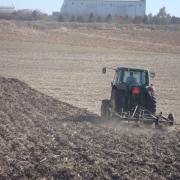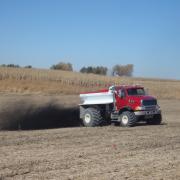By returning biochar created by fast pyrolysis to the soil, more stover residue can be harvested for bioenergy without degrading soil quality or hurting crop yields in the long run.
Table of Contents
- Research Activities
- What We Have Learned
- Why is This Important?
- For More Information
- Contributors to this Summary
Research Activities

Biochar being incorporated by tillage.
|
|
Photo: David Laird, Iowa State University. |
David Laird, professor of agronomy at Iowa University, hypothesized that biochar could be used as a soil amendment to enhance the sustainability of stover harvest. Biochar helps maintain soil quality; it can also help mitigate greenhouse gas emissions and climate change by sequestering carbon in the soil.
Biochar was surface-applied at a rate of 10 tons per acre on 16 large plots at the Iowa State University Armstrong research farm and incorporated by tillage to a depth of 6 inches. The experiment is a split-plot design with continuous no-tillage corn as a control; and bioenergy switchgrass, low-diversity high-input polyculture, and high-diversity low-input polyculture cropping systems. The changes in soil quality, soil carbon sequestration, stand density and diversity, and biomass and grain production are being monitored.
Laird’s research is part of CenUSA Bioenergy, a coordinated research and education effort, funded by the USDA’s National Institute of Food and Agriculture.
What We Have Learned
In Midwest prairie states, like Iowa, biochar is a natural ingredient in soils, the result of thousands of years of prairie fires. In that ancient system, however, the fire’s energy was wasted. Today biochar can be created as a by-product of the fast pyrolysis process, turning biomass like corn stover into useable energy.
Then, by returning biochar to the soil as an amendment, growers can harvest more of a crop’s stover for bioenergy without jeopardizing soil quality or yields. In fact, biochar may improve crop yields in poorer soils. Biochar retains about half the nutrients of the original biomass, including potash, phosphorus, nitrogen and minerals, and also boosts soil organic matter.
“Biochar is the manure of the bioenergy industry, a way of building soils,” according to Laird.
Why is This Important?
Farmers growing corn and other feedstocks for renewable energy usually want to remove as much stover as possible, not only to make more money from selling it for bioenergy but because more stover removal usually boosts corn yields.

Biochar being applied.
|
| Photo: David Laird, Iowa State University. |
But that is a benefit only in the short run. In the long run, as less residue is left behind, the soil will be more susceptible to erosion, and soil quality will decline as organic matter —humus—and moisture-holding capacity drop off.
The ability of soil to retain moisture is especially critical in drought years like 2012.
It’s a short-term benefit with a long-term cost,” Laird says. “The key thing is, if we go on with business as usual and harvest residue for bioenergy products, it’s not going to be sustainable. So we have to change practices if we want to harvest stover, and find new ways to compensate for removal,” Laird says.
Biochar is one of the most promising new practices. For instance, in one study, biochar improved soil’s water-holding capacity by 15 percent. Biochar may also be able to improve crop yields in fields with less than optimal soil.
For More Information
- Contact Dr. David Laird, Professor of Agronomy, Iowa State University, 515-294-1581, email: dalaird@iastate.edu.
- US Biochar Conference 2012. Video on the Role of Biochar in Achieving a Carbon Negative Economy
- This Research Summary is part of the CenUSA Learning Module on Sustainable Feedstock Production.
Contributors to this Research Summary
Authors
- David Laird, Professor of Agronomy, Iowa State University
- Susan J. Harlow, Freelance Journalist
Peer Reviewer
- Ann Johanns, Department of Economics, Iowa State University
CenUSA Bioenergy is a coordinated research and education effort investigating the creation of a regional system in the Central US for producing advanced transportation fuels from perennial grasses on land that is either unsuitable or marginal for row crop production. In addition to producing advanced biofuels, the proposed system will improve the sustainability of existing cropping systems by reducing agricultural runoff of nutrients in soil and increasing carbon sequestration.
CenUSA is supported by Agriculture and Food Research Initiative Competitive Grant no. 2011-68005-30411 from the USDA National Institute of Food and Agriculture.


